
The biscuit of the proto-porcelain is made from porcelain stone which is composed essentially of silica (more than 70%) and alumina (less than 20%) and small amount of other oxides (they served as flux to lower the melting temperature of silica and alumina) such as iron oxides , titanium dioxide, calcium oxide, magnesium oxide, potassium oxide, sodium oxide and manganese oxide. During firing some of the silica and alumina melts into molten glassy glaze and upon cooling cements the remaining material of the body of the vessel. In south China, the source of the porcelain stone is weathered igneous rocks. The body of the vessel is coated with a glaze made from a composition of porcelain stone and wood ash. The high calcium oxide in the wood ash serves as flux to melt the porcelain stone to the glass-like glaze. The green or yellowish green colour is the result of the colorant iron oxide. When the ware is fired under a reduction or oxygen deficient atmosphere, it turns green. If it is an oxidation (oxygen-rich) atmosphere, the glaze appears yellow or yellowish green. The firing temperature for proto porcelain is around 1200 degree centigrade as compared to around 1000 for pottery. In the Western context, proto-porcelain is still classified as stoneware as it lacks the translucence of typical porcelain. However, from the Chinese point of view, proto porcelain was the origin and irreplaceable link in the evolution to true porcelain in the History of Chinese porcelain production.
Proto-porcelains of Shang and Zhou Era
So far, all evidence (including chemical analysis) show that proto-porcelains were first produced by potters in Southern China as early as during the Shang dynasty (more than 3,000 years ago). In Zhejiang province, kiln sites producing Late Shang/Zhou proto-porcelain and impressed design hard-fired pottery have been discovered in counties such as Shaoxing (绍兴),Xiaoshan (萧山), Zhuji (诸暨), Deqing (德清), Wuxing (吴兴) counties. Remains of Shang period dragon kilns were also uncovered at Shangyu (上虞李家山) and other places in Deqing and Shaoxing. There are also ancient Shang/Zhou kiln sites found in Yixing (宜兴) in Jiangsu province (江苏).

The below jar, a wine vessel "zun" (尊) was excavated from the tomb of a noble in Zhengzhou (郑州), Henan province (the Shang capital then). The body is grayish with a grayish brownish glaze on the interior and exterior of the vessel.
|
|
Shang Zun (尊) |
Shang
proto-porcelain vessels consisted mainly of various type of jars (尊
,罐,
瓮),
shallow plates and stem bowls (豆). The
paste appears coarse and grayish white, grayish brown or buff in colour. The
glaze is uneven and colour ranges from green yellowish green, brown or
greyish green. The adhesion of the glaze is poor and flakes easily.
The vessels are irregular in shape, and with uneven thickness wall.
They appear to be coil-built and finished on a slow wheel. The
decorative designs include impressed basket weave, square, comb, circles,
chevron or applique S-shapes.
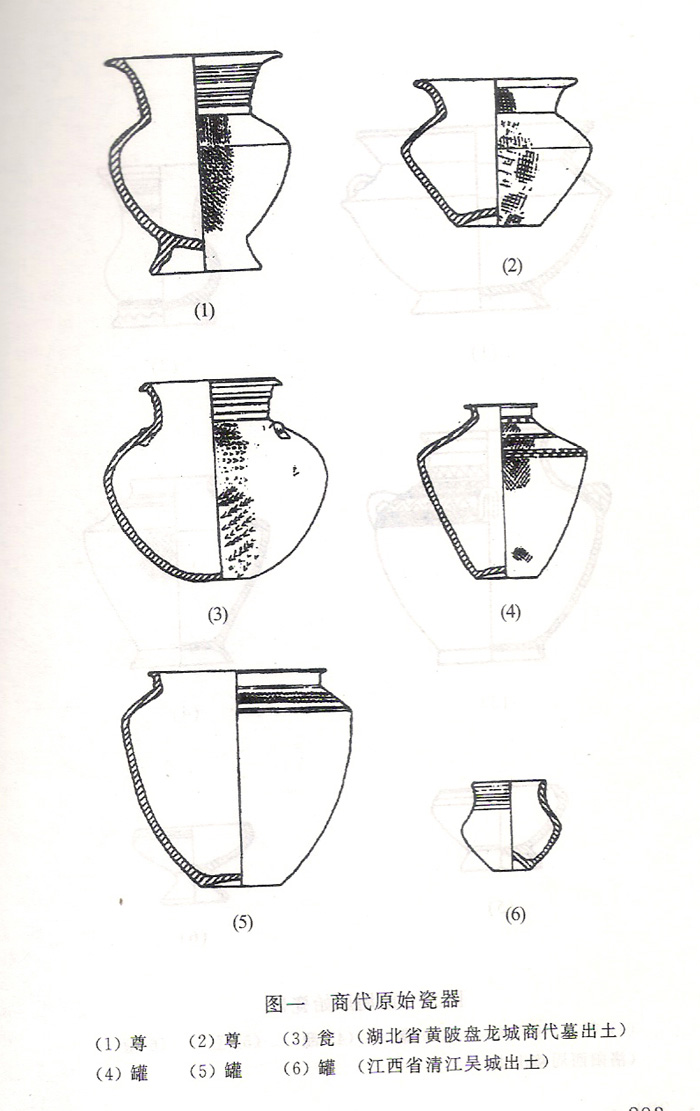
Shang Dynasty. Various types of Jar
Early/Mid Shang proto porcelains were discovered in ancient sites and tombs in regions around the yellow river in Henan (河南), Hebei (河北), Shanxi (山西) and Yangxi river (长江) Hubei (湖北), Hunan (湖南), Jiangsu (江苏) and Jiangxi (江西) . By the late Shang period, the regions using proto-porcelains had expanded including Zhejiang (浙江) and even Fujian (福建). Findings of proto-porcelains was relatively rare prior to late Shang Period. The number increased significantly by the late Shang period.
During the Western Zhou period, the regions using proto-porcelains expanded further to include Shanxi (陕西) and Anhui (安徽). The findings were especially high in Zhejiang and Southern Jiangsu and Southern Anhui. The vessels showed similarity to those from Shang period but with some changes. For example, instead of the concave small base , during the Western Zhou period, it has become a bigger flat base or flaring footring for greater stability. As for the motifs, impressed circles and basket weaves lost favour and were seldom used.
Vessels were still limited in variety, with jars, stem-bowls (dou), dishes and bowls forming the principal products.

Western Chou Period : 4 Jar, 5-6 stem bowl (豆)
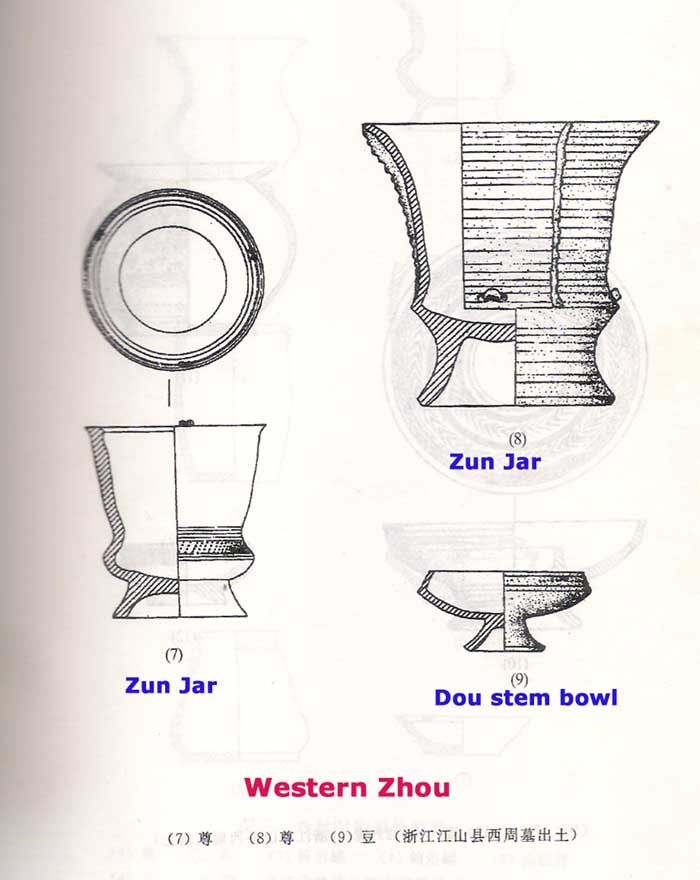
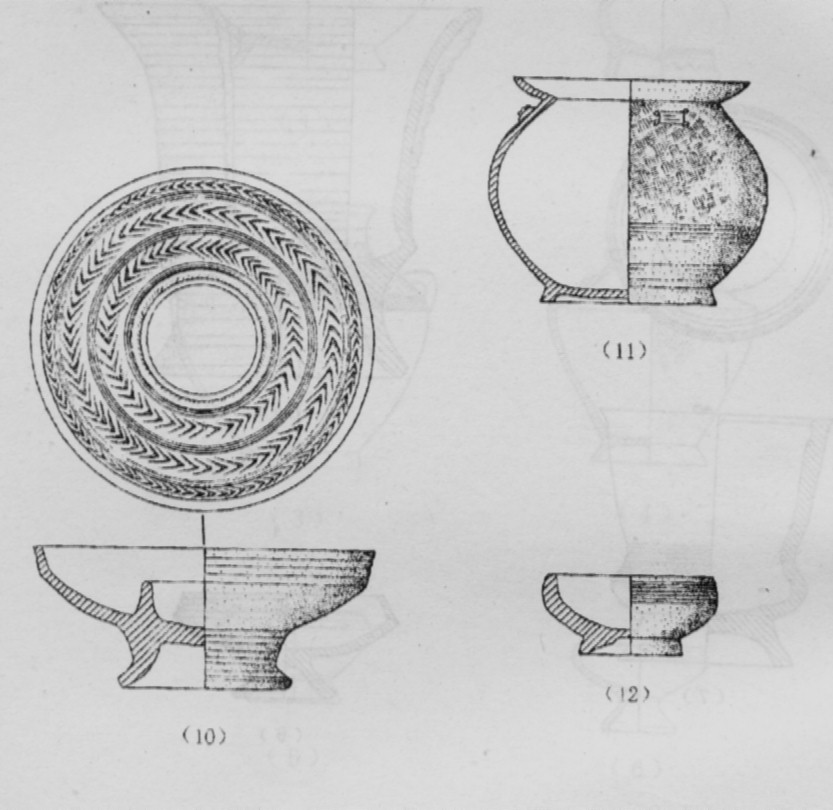
Western Chou Period : 10 stem bowl (豆) ,11 Jar, 12 bowl

stem bowl (豆)
By the Western Zhou Period, more mature proto-porcelain were produced as can be seen in the below jar "lei". The glaze is greenish-yellow in colour, thicker and smoother.
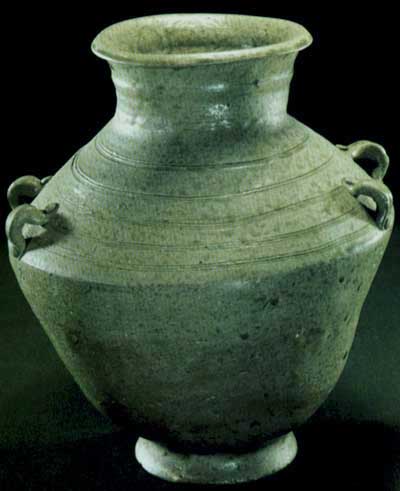
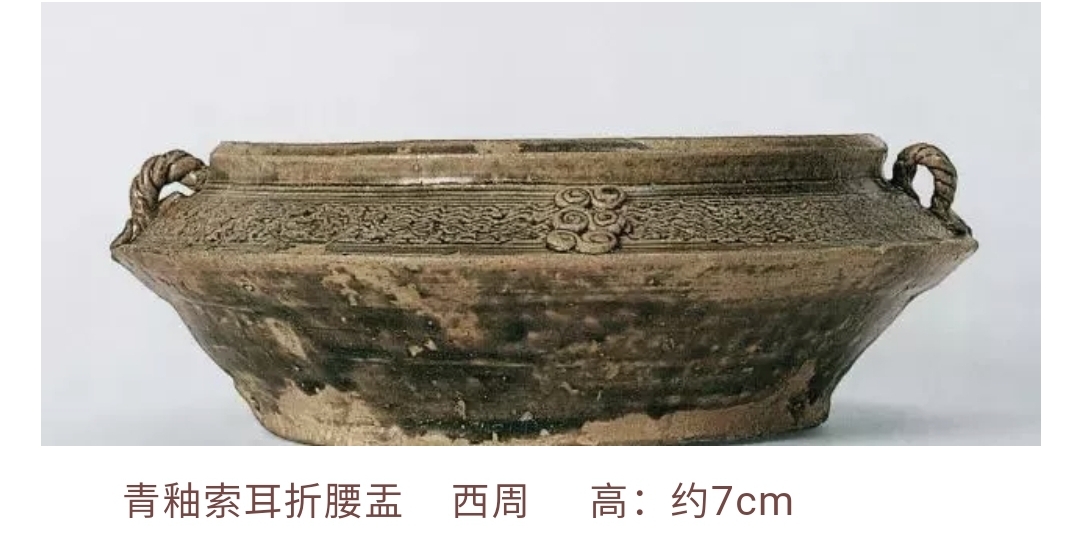
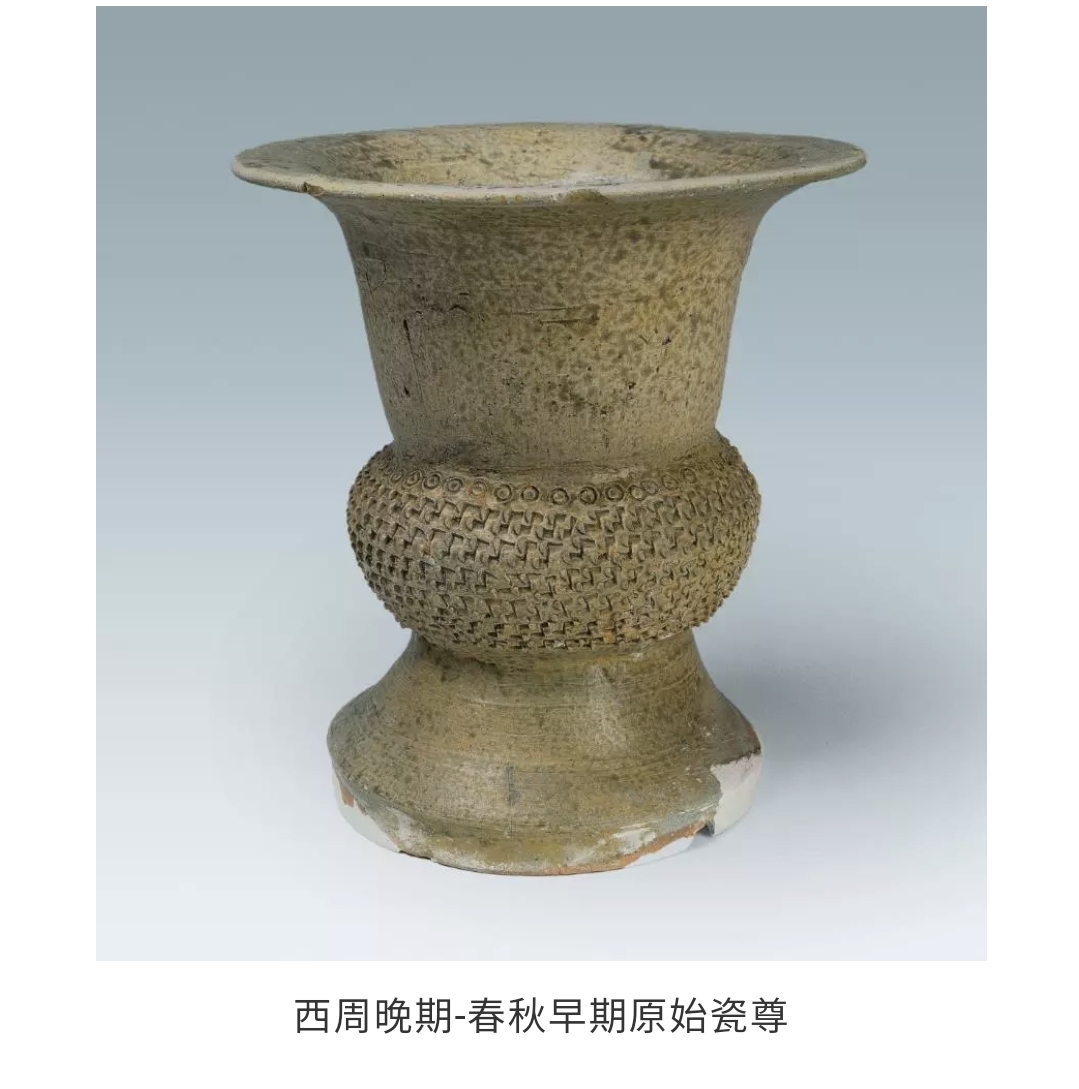



Some examples of Western Zhou vessels
Vessels of the Shang and Western Zhou era were made by coiling process, further shaped by padding and the finishing touch done on a slow wheel. This is obvious as the profile of the vessels generally appears crooked. The wall of the vessels are also of uneven thickness. The body of the vessels also have uneven patches left during the padding process. On many of the vessels, a pottery pad with carved motif was used to pad the motif on the body of the vessels. This not only beautify the vessels but also conceal the uneven patches on the body. Comparatively, those of the later period were formed by fast wheel. The surface of the vessels is thus smoother. It is therefore not necessary to smoothen the surface with a pad. Hence, impressed/incised motifs were usually reserved for area around the shoulder of the vessel.
By Eastern Zhou Spring and Autumn and Warring States era (841-221 B.C.), production of proto-porcelain reached its peak. Large quantities and improved quality products were produced at kilns in Zhejiang (domain of ancient state o Yue (越国) ,especially around Shaoxing (绍兴), Xiaoshan (萧山) and Deqing (德清). Those sites were all extensive and rich in shard accumulations. Most of the proto-porcelains of this period were found in the Jiangsu and Zhejiang region. Very little proto-porcelains were found in regions around the yellow river.
The vessels produced were much more varied. Apart from functional wares such as bowls, dishes, cups, jars and ritual vessels which imitated the bronze forms such as tripod cauldrons (鼎) , wine warmers and musical instruments . The lugs on the vessels generally do not have a hole and is decorative in nature.
By the beginning of the Warring states, bowls became cylindrical in form and the wall near the rim is thin. Big jars for storage which were popular in the early period ceased to be produced. The vessels were well-formed with thin even thickness wall as fast wheel was used to make them. The body of the vessel is fine-grained with relatively low level of iron-oxide. It is light grayish white or buff in colour. The glaze is smooth and more greenish in color. Chemical analysis by the Chinese scientists showed that they had almost all the features of mature porcelain ware.
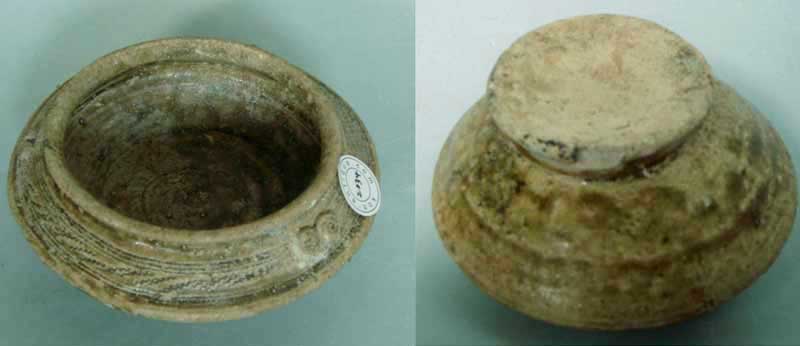
Spring and Autumn Period vessel |
|
Spring and Autumn Period tripod in Shanghai Museum |
|
|
| Warring States Musical instrument in Shanghai Museum |
|
|
| Warring States Cup in Shanghai Museum |
|
|
| Warring States Jar in Shanghai Museum |
In the year 323 BC, the state of Yue (越国) was destroyed by the army of the state of Chu (楚国). The devastation was so complete that even production of proto-porcelains was disrupted. In fact, no proto-porcelains of this period were uncovered during archeological excavations of ancient kiln sites and tombs around Shaoxing and Xiaoshan.
Proto-porcelains of Qin and Western Han Era
The production of proto-porcelains resumed sometime during the Qin Dynasty. The kilns were mainly located in Zhejiang and some in Southern Jiangsu. Those were areas which Shang/zhou proto porcelains were produced.
The products of Qin and Western Han era were much inferior to those of the Spring and Autumn and Early Warring States era. There is a lack of attention to the selection and processing of the raw material. As a result, the finished products have grayish or dark grayish bodies and are coarse and porous. After firing, it tends to oxidise into a dark purplish or dark brownish colour. The thick glaze, often dark green or yellowish-brown in colour, was applied only to areas around the mouth, shoulder and upper belly. The base and body were usually made separately and then joined together by luting. In comparison, the products of the Warring States era were glazed both on the interior and exterior.
During the Qin to early west Han period, mainly tripod cauldrons, jars, cover boxes, jars and Hu vases were produced. Food vessels such as bowls, dishes and cups, which were popular during the Warring States era were seldom found.

By the Mid Western Han, cauldrons and cover boxes were produced in smaller number. Both have deeper belly. The foot of the cauldron also became shorter and for cover boxes boxes, there is no longer any footring. For a type of jar with animal mask handles (item no. 2 of above diagram), the foot disappeared and the belly became deeper (see item no. 3 of below diagram). For the Hu vase, the high footring was also no longer present.
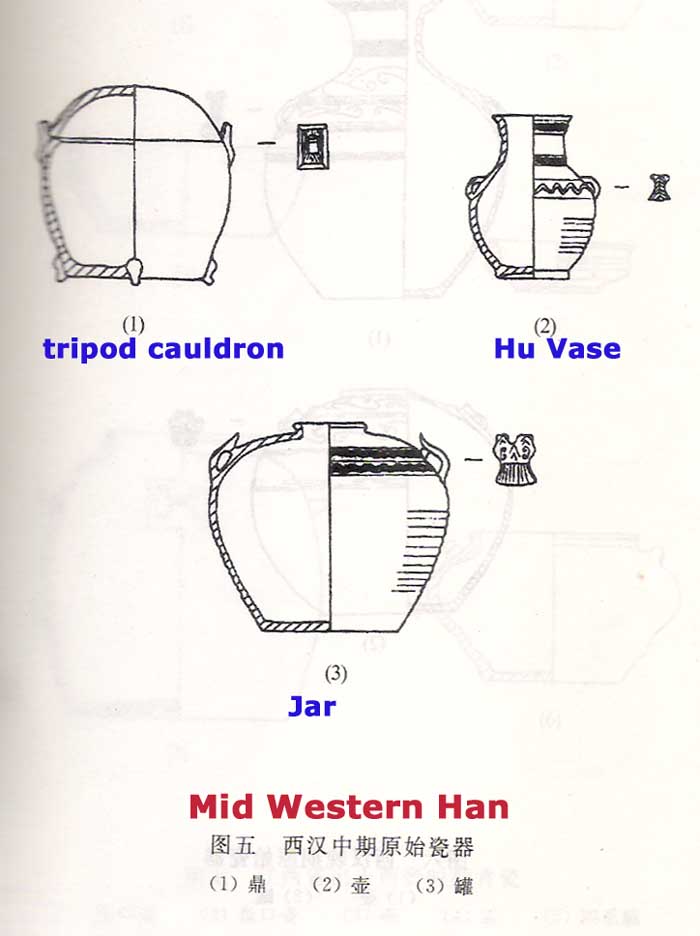
During the late Western Han period, more utilitarian vessels such as jars, hu vases, plates and bowls were produced. The hu vases have trumpet shaped mouth and flatter base. The shoulder portion of Hu vase and jars were sometime decorated with beautiful incised cloud and mystical birds motif.
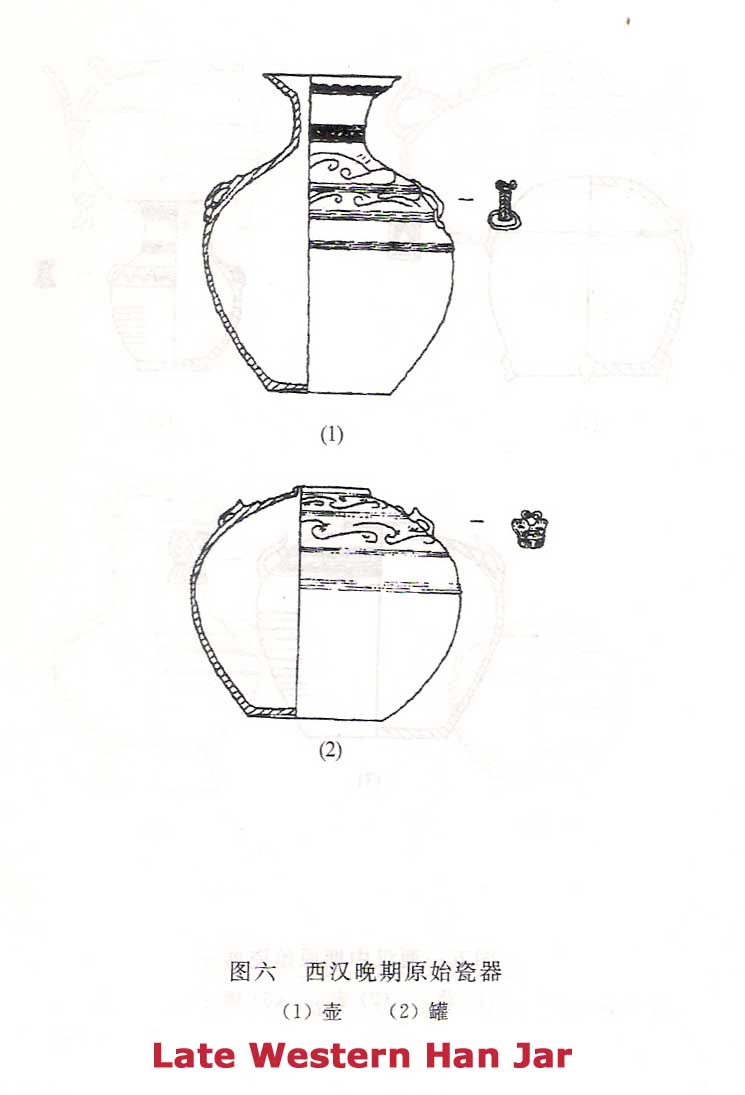
|
|
|
|
Early
Western Han (left) and Late Western Han Jar. The latter has the
finely incised cloud and mystical motif.
Notice the two round white bluish patches on the above jar. Such splashes mostly occurred as a result of glassy, ash rich drops that fell from the roof of the wood-burning kiln during firing. The Chinese called them kiln sweats (窑汗). Both items are the collection of the Lee Kong Chian Museum in Singapore. |
|

Written: NK
Koh (22 Mar 2008) Updated: (15 May 2010,5 Oct 2021)
References:
1 中国陶瓷 冯先铭 主编
2 Chinese Glazes by Nigel Wood